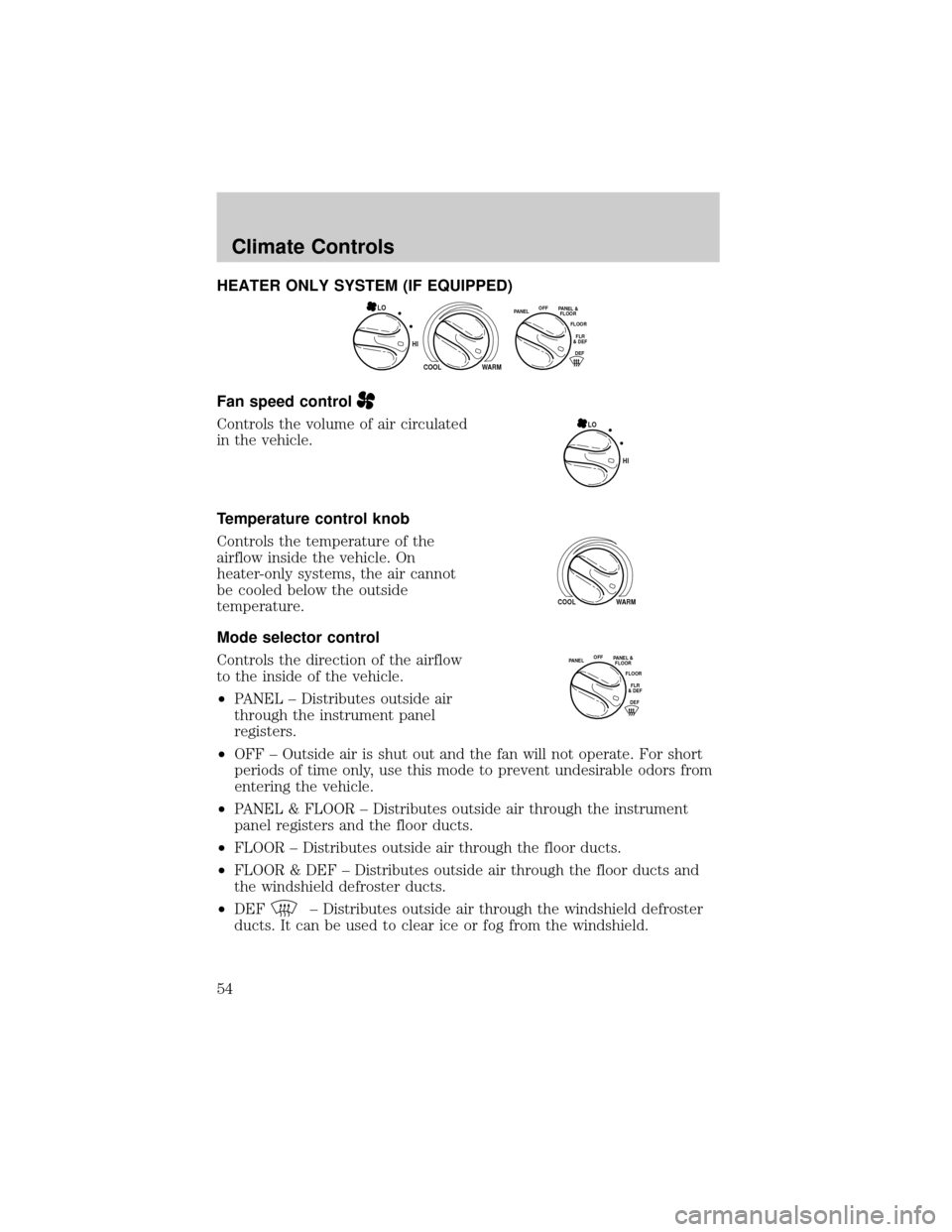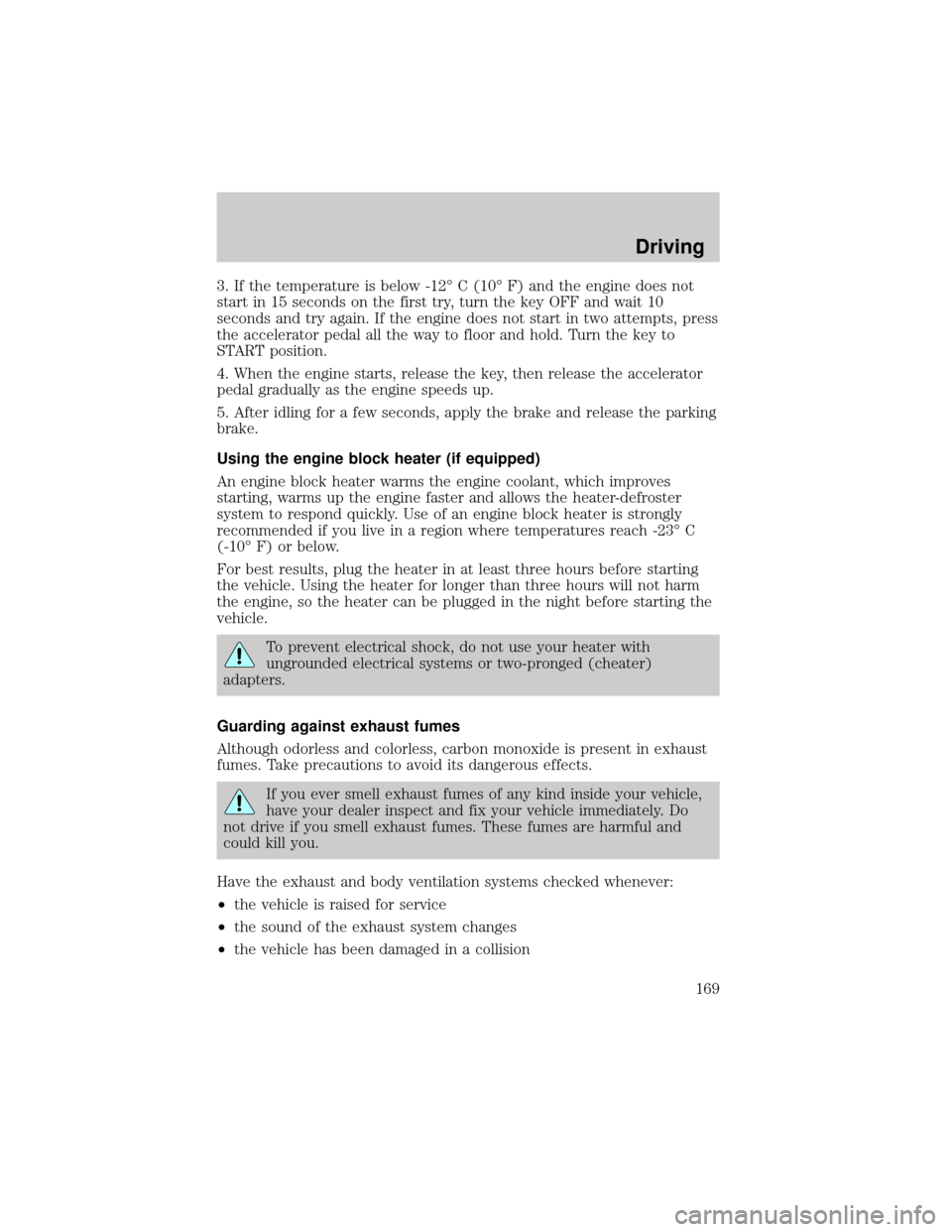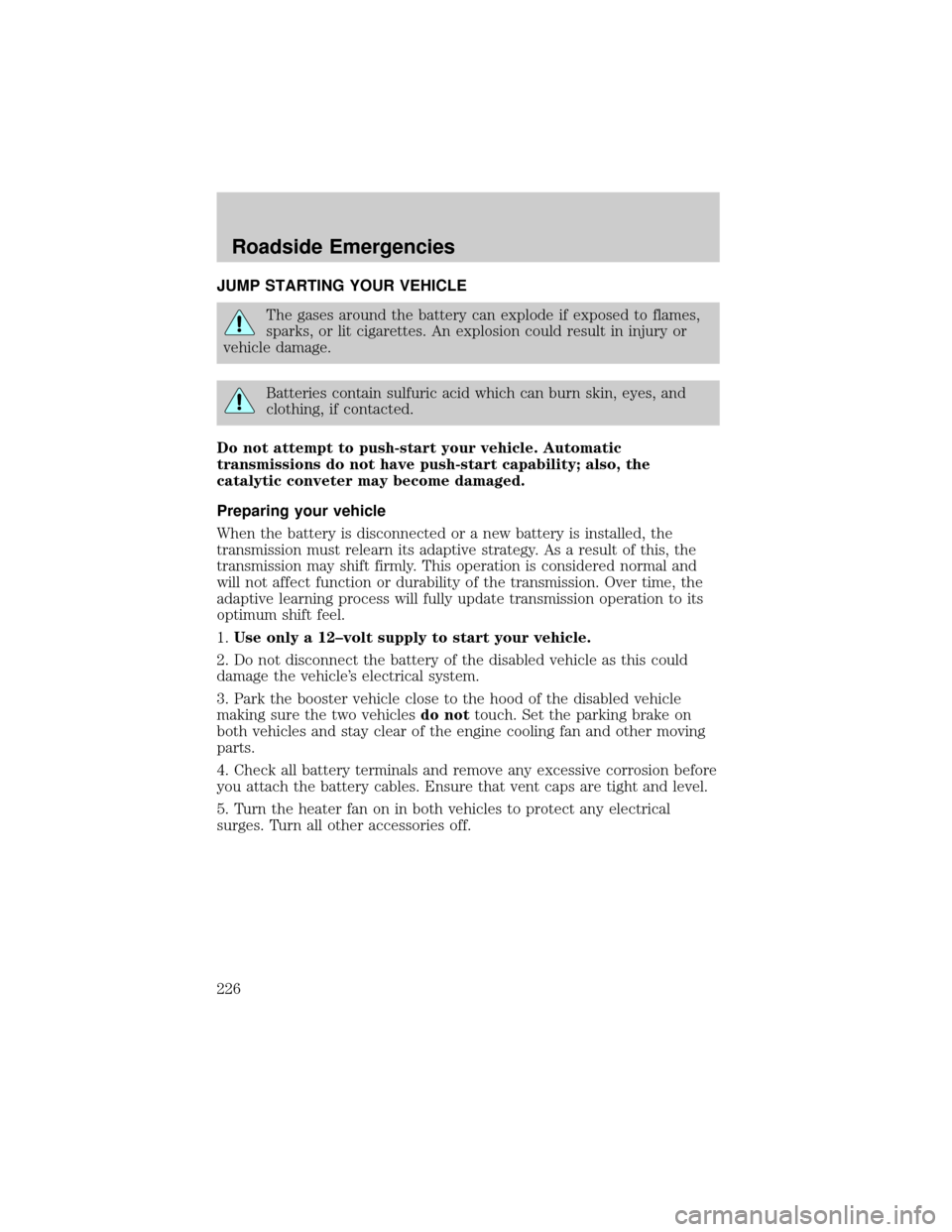2002 FORD F150 heater
[x] Cancel search: heaterPage 1 of 320

Introduction 4
Congratulations 4
Safety and environment protection 5
Symbol glossary 8
Instrument Cluster 10
Warning and control lights 10
Gauges 16
Entertainment Systems 20
AM/FM stereo cassette 20
AM/FM stereo with CD 27
AM/FM stereo cassette (CD changer compatible) 36
CD changer 49
Climate Controls 54
Heater only 54
Manual heating and air conditioning 55
Electronic automatic temperature control 59
Lights 65
Headlamps 65
Bulb replacement 69
Driver Controls 76
Steering wheel adjustment 77
Power windows 85
Mirrors 87
Locks and Security 106
Keys 106
Locks 106
Anti-theft system 108
Table of Contents
1
Page 54 of 320

HEATER ONLY SYSTEM (IF EQUIPPED)
Fan speed control
Controls the volume of air circulated
in the vehicle.
Temperature control knob
Controls the temperature of the
airflow inside the vehicle. On
heater-only systems, the air cannot
be cooled below the outside
temperature.
Mode selector control
Controls the direction of the airflow
to the inside of the vehicle.
²PANEL ± Distributes outside air
through the instrument panel
registers.
²OFF ± Outside air is shut out and the fan will not operate. For short
periods of time only, use this mode to prevent undesirable odors from
entering the vehicle.
²PANEL & FLOOR ± Distributes outside air through the instrument
panel registers and the floor ducts.
²FLOOR ± Distributes outside air through the floor ducts.
²FLOOR & DEF ± Distributes outside air through the floor ducts and
the windshield defroster ducts.
²DEF
± Distributes outside air through the windshield defroster
ducts. It can be used to clear ice or fog from the windshield.
HI
COOL WARM
OFFPANELFLOOR
DEFFLR
& DEF PANEL &
FLOOR
LO
HI LO
COOL WARM
OFFPANELFLOOR
DEFFLR
& DEF PANEL &
FLOOR
Climate Controls
54
Page 169 of 320

3. If the temperature is below -12É C (10É F) and the engine does not
start in 15 seconds on the first try, turn the key OFF and wait 10
seconds and try again. If the engine does not start in two attempts, press
the accelerator pedal all the way to floor and hold. Turn the key to
START position.
4. When the engine starts, release the key, then release the accelerator
pedal gradually as the engine speeds up.
5. After idling for a few seconds, apply the brake and release the parking
brake.
Using the engine block heater (if equipped)
An engine block heater warms the engine coolant, which improves
starting, warms up the engine faster and allows the heater-defroster
system to respond quickly. Use of an engine block heater is strongly
recommended if you live in a region where temperatures reach -23É C
(-10É F) or below.
For best results, plug the heater in at least three hours before starting
the vehicle. Using the heater for longer than three hours will not harm
the engine, so the heater can be plugged in the night before starting the
vehicle.
To prevent electrical shock, do not use your heater with
ungrounded electrical systems or two-pronged (cheater)
adapters.
Guarding against exhaust fumes
Although odorless and colorless, carbon monoxide is present in exhaust
fumes. Take precautions to avoid its dangerous effects.
If you ever smell exhaust fumes of any kind inside your vehicle,
have your dealer inspect and fix your vehicle immediately. Do
not drive if you smell exhaust fumes. These fumes are harmful and
could kill you.
Have the exhaust and body ventilation systems checked whenever:
²the vehicle is raised for service
²the sound of the exhaust system changes
²the vehicle has been damaged in a collision
Driving
169
Page 226 of 320

JUMP STARTING YOUR VEHICLE
The gases around the battery can explode if exposed to flames,
sparks, or lit cigarettes. An explosion could result in injury or
vehicle damage.
Batteries contain sulfuric acid which can burn skin, eyes, and
clothing, if contacted.
Do not attempt to push-start your vehicle. Automatic
transmissions do not have push-start capability; also, the
catalytic conveter may become damaged.
Preparing your vehicle
When the battery is disconnected or a new battery is installed, the
transmission must relearn its adaptive strategy. As a result of this, the
transmission may shift firmly. This operation is considered normal and
will not affect function or durability of the transmission. Over time, the
adaptive learning process will fully update transmission operation to its
optimum shift feel.
1.Use only a 12±volt supply to start your vehicle.
2. Do not disconnect the battery of the disabled vehicle as this could
damage the vehicle's electrical system.
3. Park the booster vehicle close to the hood of the disabled vehicle
making sure the two vehiclesdo nottouch. Set the parking brake on
both vehicles and stay clear of the engine cooling fan and other moving
parts.
4. Check all battery terminals and remove any excessive corrosion before
you attach the battery cables. Ensure that vent caps are tight and level.
5. Turn the heater fan on in both vehicles to protect any electrical
surges. Turn all other accessories off.
Roadside Emergencies
226
Page 309 of 320

FORD ACCESSORIES FOR YOUR VEHICLE
A wide selection of genuine Ford accessories are available for your
vehicle through your local authorized Ford, Lincoln, Mercury or Ford of
Canada dealer. These quality accessories have been specifically
engineered to fulfill your automotive needs; they are custom designed to
complement the style and aerodynamic appearance of your vehicle. In
addition, each accessory is made from high quality materials and meets
or exceeds Ford's rigorous engineering and safety specifications. Ford
Motor Company will repair or replace any properly dealer-installed Ford
accessory found to be defective in factory-supplied materials or
workmanship during the warranty period, as well as any component
damaged by the defective accessory. The accessory will be warranted for
whichever provides you the greatest benefit:
²12 months or 20 000 km (12 000 miles) (whichever occurs first), or
²The remainder of your new vehicle limited warranty.
This means that genuine Ford accessories purchased along with your
new vehicle and installed by the dealer are covered for the full length of
your New Vehicle's Limited Warranty Ð 3 years or 60 000 km (36 000 miles)
(whichever occurs first). Contact your dealer for details and a copy of
the warranty.
Not all accessories are available for all models.
Vehicle Security
Styled wheel locks
Vehicle security systems
Comfort and convenience
Air conditioner
Air filtration systems
Automatic Headlamp System with Daytime Running Lights (DRL)
Cargo organizers (interior)
Cargo storage bin (regular cab)
Cargo trays (interior)
Celluar phone holder
Dash trim (wood grain)
Engine block heaters
Manual sliding rear window
Accessories
309
Page 315 of 320

E
Emergencies, roadside
jump-starting ..........................226
Emission control system ..........280
Engine ................................301±302
check engine/service
engine soon light ......................11
cleaning ...................................244
coolant .....................................265
fail-safe coolant ......................270
idle speed control ...................263
lubrication
specifications ..................299, 301
refill capacities ........................295
service points ..................255±257
starting after a collision .........211
Engine block heater .................169
Engine oil ..................................258
checking and adding ..............258
dipstick ....................................258
filter, specifications ........262, 294
recommendations ...................262
refill capacities ........................295
specifications ..................299, 301
Exhaust fumes ..........................169
F
Fail safe cooling ........................270
Floor mats ...................................97
Fluid capacities .........................295
Foglamps .....................................65
Four-Wheel Drive
vehicles ................................15, 184
description ..............................187
driving off road .......................188
electronic shift ........................187indicator light ...................15, 185
lever operated shift ................185
preparing to drive your
vehicle .....................................174
Fuel ............................................271
calculating fuel economy .......277
cap .....................................12, 273
capacity ...................................295
choosing the right fuel ...........274
comparisons with EPA
fuel economy estimates .........280
detergent in fuel .....................276
filling your vehicle
with fuel ..................271, 273, 277
filter, specifications ........276, 294
fuel pump shut-off switch .....211
gauge .........................................18
improving fuel economy ........277
low fuel warning light ..............13
octane rating ...274±275, 301±302
quality ......................................275
running out of fuel .................276
safety information relating
to automotive fuels ................271
Fuses ..................................213±214
G
Garage door opener ..............79, 93
Gas cap (see Fuel cap) ......12, 273
Gas mileage
(see Fuel economy) .................277
Gauges .........................................16
battery voltage gauge ...............18
engine coolant temperature
gauge .........................................17
engine oil pressure gauge ........17
fuel gauge ..................................18
odometer ...................................19
speedometer .............................18
Index
315
Page 316 of 320

tachometer ................................19
trip odometer ............................19
GAWR (Gross Axle
Weight Rating) ..........................197
calculating ...............................199
definition .................................197
driving with a heavy load ......197
location ....................................197
GVWR (Gross Vehicle
Weight Rating) ..........................197
calculating .......................197, 199
definition .................................197
driving with a heavy load ......197
location ....................................197
H
Hazard flashers .........................211
Head restraints .........................120
Headlamps ...................................65
aiming ........................................67
autolamp system .......................65
bulb specifications ....................70
daytime running lights .............66
flash to pass ..............................66
high beam ...........................14, 66
replacing bulbs .........................71
turning on and off ....................65
warning chime ..........................15
Heating ........................................59
heater only system ...................54
heating and air conditioning
system .......................................55
HomeLink universal
transceiver
(see Garage door opener) ...93±96
Hood ..........................................254I
Ignition .......................165, 301±302
removing the key ....................184
Infant seats
(see Safety seats) .....................155
Inspection/maintenance
(I/M) testing ..............................281
Instrument panel
cleaning ...................................248
cluster ................................10, 248
lighting up panel
and interior ...............................67
J
Jack ............................................220
positioning ...............................220
storage .....................................220
Jump-starting your vehicle ......226
K
Keyless entry system
autolock ...................................113
locking and unlocking
doors ........................................115
programming entry code .......114
Keys ...................................116±118
key in ignition chime ...............15
positions of the ignition .........165
removing from the ignition ....184
L
Lamps
autolamp system .......................65
bulb replacement
specifications chart ..................70
cargo lamps ...............................67
Index
316